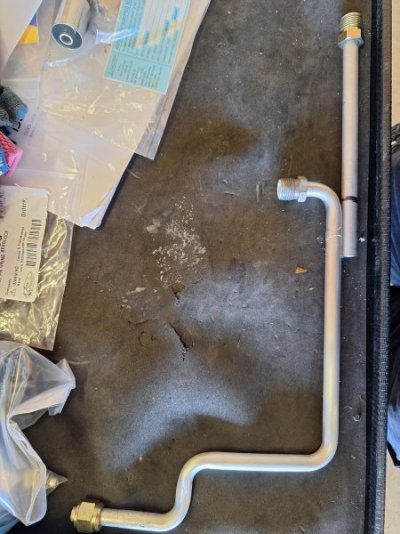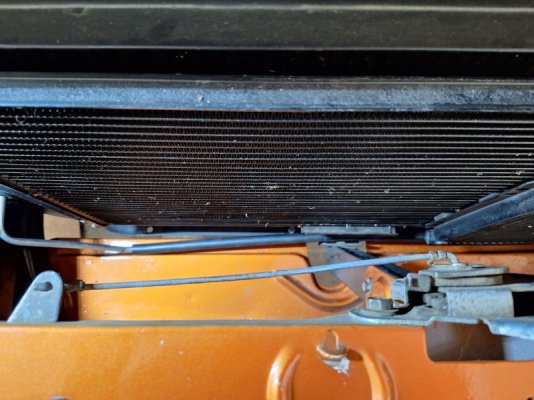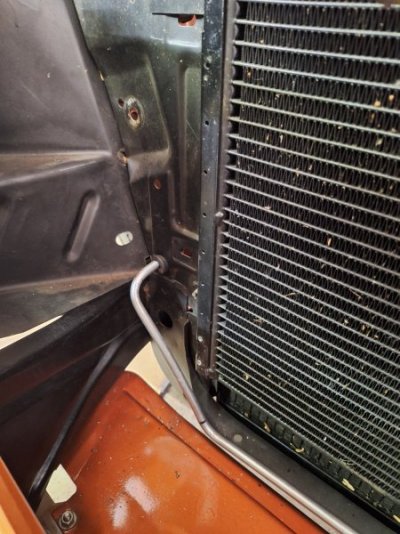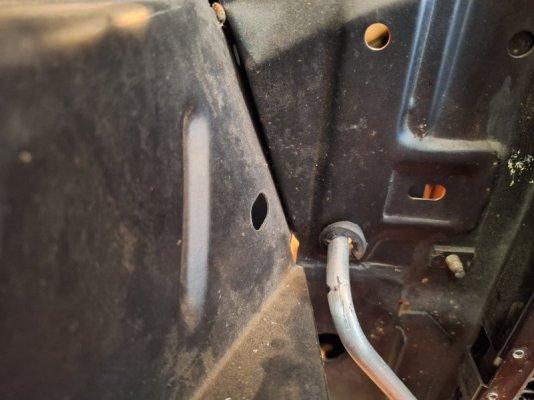This will work on the Dart too. Thanks.You can unplug the clutch lead and simply jumper it to the battery terminal of the alternator... That way you have 100% control, you know when the clutch is energized & you see how it responds...
You are using an out of date browser. It may not display this or other websites correctly.
You should upgrade or use an alternative browser.
You should upgrade or use an alternative browser.
Installing Classic Auto Air in a '70 Charger
- Thread starter Kern Dog
- Start date
Ray70Chrg
Well-Known Member
I'm just as new to this as any of you, but I have read that O rings on a 134 system should be lubed with its pag oil and never mineral oil. It will destroy the o rings. Mineral oil is only used on R12 systems. I got this info while learning about Senden compressors.All the crimps, fittings, and O rings are new and the O rings were lubricated in mineral oil.
1 Wild R/T
Well-Known Member
Never heard of a Senden compressor.... Never heard anyone suggest mineral oil would damage O rings either...I'm just as new to this as any of you, but I have read that O rings on a 134 system should be lubed with its pag oil and never mineral oil. It will destroy the o rings. Mineral oil is only used on R12 systems. I got this info while learning about Senden compressors.
Ray70Chrg
Well-Known Member
Well take it for whats its worth. I admire your many years as a mechanic and have learned many things from you. Senden sd508 is the model that most of these other companies follow that are on the market now. They all claim to be "Senden style". I'll receive a compressor from them tomorrow.Never heard of a Senden compressor.... Never heard anyone suggest mineral oil would damage O rings either...
Since Greg @Kern Dog already introduced my ac install on the Coronet, I'll post some pics here instead of starting a new thread.
This is the genesis of Greg's thread on the art of welding Al. The hardline from the condenser leading to the compressor was engineered by CAA to extend past the battery, with the hose from the compressor draping over the valve cover before connecting to the hardline at the inner fender panel. With no battery in the way, we had a local ac shop (another shop in Greg's automotive network) cut off 3" and braze a 90° elbow fitting.

The elbow allowed a gentle S curve in the hose, giving a clean look and allowing unfettered access to the valve cover.

CAA originally paralleled the Condenser-to-Drier hardline next to the other hardline, with the hose draping over the engine to the drier on the passenger side inner fender. This really clutters up the top the engine. Instead, I bought 48" U Bend hardline and fitting from a local speed shop (American Pastimes - another one of Greg's peeps) and routed the line down and across the front of the condenser, making a 90° turn and exiting the radiator support just above the passenger side frame rail.
Bottom of the condenser, driver's side. Two 90° bends.

Running along the bottom of the condenser. The line is wrapped in 3/8" hose for anti-vibration

Jogs up through the radiator support. Pic was taken before line was wrapped. I used a step drill to enlarge the existing hole.


Much easier to route the line with the grill removed.

And... I didn't take any pictures of the engine compartment side. To be continued....
This is the genesis of Greg's thread on the art of welding Al. The hardline from the condenser leading to the compressor was engineered by CAA to extend past the battery, with the hose from the compressor draping over the valve cover before connecting to the hardline at the inner fender panel. With no battery in the way, we had a local ac shop (another shop in Greg's automotive network) cut off 3" and braze a 90° elbow fitting.

The elbow allowed a gentle S curve in the hose, giving a clean look and allowing unfettered access to the valve cover.

CAA originally paralleled the Condenser-to-Drier hardline next to the other hardline, with the hose draping over the engine to the drier on the passenger side inner fender. This really clutters up the top the engine. Instead, I bought 48" U Bend hardline and fitting from a local speed shop (American Pastimes - another one of Greg's peeps) and routed the line down and across the front of the condenser, making a 90° turn and exiting the radiator support just above the passenger side frame rail.
Bottom of the condenser, driver's side. Two 90° bends.

Running along the bottom of the condenser. The line is wrapped in 3/8" hose for anti-vibration

Jogs up through the radiator support. Pic was taken before line was wrapped. I used a step drill to enlarge the existing hole.


Much easier to route the line with the grill removed.

And... I didn't take any pictures of the engine compartment side. To be continued....
Last edited:
It's probably pag oil. The CAA instructions say 'mineral oil' and it's the oil that came with the kit.I'm just as new to this as any of you, but I have read that O rings on a 134 system should be lubed with its pag oil and never mineral oil. It will destroy the o rings. Mineral oil is only used on R12 systems. I got this info while learning about Senden compressors.
Ray70Chrg
Well-Known Member
Fine, just trying to help.
1 Wild R/T
Well-Known Member
So, after specifically searching "Mineral Oil Damage A/C O rings" I found a couple threads... On forums, I also found a Denso tech bulletin talking about PAG/Esther/Mineral oils & compressor damage... They stated The compressor needs to be lubricated by oil that is compatible with the refrigerant being used but that lubing the O rings wasn't critical..
Oh, What you are calling "Senden" is Sanden... I've installed many... And I avoid "Sanden Style" Chinese knock offs... Pay a little more & get a real Japanese made Sanden...
Oh, What you are calling "Senden" is Sanden... I've installed many... And I avoid "Sanden Style" Chinese knock offs... Pay a little more & get a real Japanese made Sanden...
Ray70Chrg
Well-Known Member
Thanks, I did
- Local time
- 9:20 PM
- Joined
- Apr 13, 2012
- Messages
- 40,373
- Reaction score
- 150,352
- Location
- Granite Bay CA
Rich's lines run a little cleaner than mine do. He has the advantage of learning from the mistakes of others.


1 Wild R/T
Well-Known Member
To further elaborate on the "Mineral Oil Damage A/C O rings" I found a couple threads... On forums, those threads had comments by posters with limited technical background, not people who've done A/C work for years...
To determine compatibility of Viton (A/C) O rings with mineral oil try this link...
Viton Chemical Compatibility Chart
Or trust me when I tell you it gets an "A" rating which = excellent...
To determine compatibility of Viton (A/C) O rings with mineral oil try this link...
Viton Chemical Compatibility Chart
Or trust me when I tell you it gets an "A" rating which = excellent...
You must've just taken those pics yesterday. Better than I have.Rich's lines run a little cleaner than mine do. He has the advantage of learning from the mistakes of others.
I wouldn't call them mistakes; I had the advantage of looking over yours and Dwayne's cars before finishing my install.
1 Wild R/T
Well-Known Member
That's how these things get better... Taking the best of other folks ideas & improving on it...
To further beat on this horse, I found a couple of references to PAG oil on the interweb:To further elaborate on the "Mineral Oil Damage A/C O rings" I found a couple threads... On forums, those threads had comments by posters with limited technical background, not people who've done A/C work for years...
To determine compatibility of Viton (A/C) O rings with mineral oil try this link...
Viton Chemical Compatibility Chart
Or trust me when I tell you it gets an "A" rating which = excellent...
Summary: Mineral Oil is used on R-12 systems, primarily on cars built prior to 1995.
PAG OIL
Polyelkylene Glycol (PAG) oil is a synthetic oil used by OEMs in their R-134a systems. PAG oils are harsher than mineral oils, and may cause skin irritation and damage O-rings and seals.
Bottom line, whatever they choose to call it, I'm sure that CAA provided the correct oil to lubricate their O rings.
- Local time
- 9:20 PM
- Joined
- Apr 13, 2012
- Messages
- 40,373
- Reaction score
- 150,352
- Location
- Granite Bay CA
Regarding the Coronet, Dwight is almost certain the leak is in the engine compartment, either an O ring fitting or crimp.
When I did my Charger, it was my first time ever with crimping lines. I actually expected to find leaks. I was surprised when the shop that I did use just did a quickie evacuation and fill while not mentioning any leaks at all. The guy that owned the shop is married to a woman that has cut my hair for 30+ years. I've built 4 roofs for them over the years so he did the job for free. The CAA instructions stated to run the system to a vacuum for 30-45 minutes at 30" of vacuum to boil out all contaminants. He didn't do that. As I've stated before, I don't know enough about this stuff to know what you can get away with. There are two mindsets I've encountered...The CAA guidelines and the skilled mechanics that have done this stuff for years. I was surprised to learn that you can draw the system down to the aforementioned 30" of vacuum, it can stay there for the 30-45 minutes yet it can still have a leak when filled with freon and under operating pressure.
Either reason is a bit disheartening because Greg and I spent a lot of time mapping out a clean install for the hardlines and hoses. All the crimps, fittings, and O rings are new and the O rings were lubricated in mineral oil. This was my first time ever using the hydraulic hose crimper; every collar seemed to crimp down just fine. At this point I'll probably use Greg's ac shop; they've worked on his Charger and Dwayne's Satellite.
Yeah, it is a punch to the face when you think you did a good job and there are still problems. If I did more of these installations, I'd be comfortable spending the money to buy more tools for it.
As it is, I'm still struggling with the electronic ignition systems and I still can't figure out how to braze/solder A/C lines. I'm trying to get better though.
Last edited:
1 Wild R/T
Well-Known Member
Mineral oil works well with R12, always did... R134 doesn't bond with mineral oil so the oil puddles in the condenser & evaporator rather than circulate through the system... That leads to compressor failures...
PAG oil does work well with R134 & was used in a OE R134 systems... But in the early days of retrofitting R12 systems it was found that no matter how much you flushed the system putting PAG oil in a system that had mineral oil, there would be residual mineral oil & mineral oil isn't compatible with PAG oil... It creates a nasty gray sludge... And to fix it you'll wind up replacing the whole system...
Then they came up with Esther oil... It works with R134 & doesn't react with mineral oil... But doesn't lubricate as effectively as PAG or mineral oil...
Early PAG oil was either PAG 100 or PAG 150
More recently PAG 46 has been the answer, it lubricates better than Esther & doesn't react with mineral oil
Anyway, lubing O rings? The key is lube them, you can use mineral oil, PAG oil, Esther, WD-40. Silicone grease... Just make them slide easy so they don't bind and tear.... Once the O ring is properly captured it won't degrade in a few weeks or months... Or even years.. If the Oring leaks either it was pinched, or the area where it is captured is damaged or incorrectly machined.. With so much coming from China this has been a bigger problem that you might think...
PAG oil does work well with R134 & was used in a OE R134 systems... But in the early days of retrofitting R12 systems it was found that no matter how much you flushed the system putting PAG oil in a system that had mineral oil, there would be residual mineral oil & mineral oil isn't compatible with PAG oil... It creates a nasty gray sludge... And to fix it you'll wind up replacing the whole system...
Then they came up with Esther oil... It works with R134 & doesn't react with mineral oil... But doesn't lubricate as effectively as PAG or mineral oil...
Early PAG oil was either PAG 100 or PAG 150
More recently PAG 46 has been the answer, it lubricates better than Esther & doesn't react with mineral oil
Anyway, lubing O rings? The key is lube them, you can use mineral oil, PAG oil, Esther, WD-40. Silicone grease... Just make them slide easy so they don't bind and tear.... Once the O ring is properly captured it won't degrade in a few weeks or months... Or even years.. If the Oring leaks either it was pinched, or the area where it is captured is damaged or incorrectly machined.. With so much coming from China this has been a bigger problem that you might think...
Exactly. The O rings are a few years old but have been stored in a sealed plastic bag. I'm going back and checking that all the fittings are tight. Other than that, its time to take it in to a shop for leak detection.Anyway, lubing O rings? The key is lube them, you can use mineral oil, PAG oil, Esther, WD-40. Silicone grease... Just make them slide easy so they don't bind and tear.... Once the O ring is properly captured it won't degrade in a few weeks or months... Or even years.. If the Oring leaks either it was pinched, or the area where it is captured is damaged or incorrectly machined.. With so much coming from China this has been a bigger problem that you might think...
Similar threads
- Replies
- 26
- Views
- 3K
- Replies
- 6
- Views
- 833
- Replies
- 17
- Views
- 1K
















